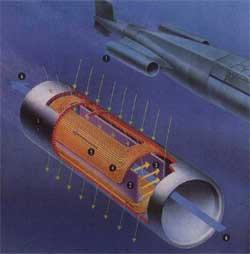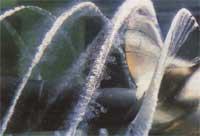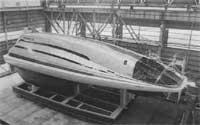Engine, propeller and motto, about to be overcome
The electromagnetic energy of sea water is no longer fiction that very quiet and ambitious divers are made without motors or moving parts. It is not yet, but very advanced studies and in many countries. After a few years, the discoveries about the magneto-hydro-dynamic impulse (MHD) have become very relevant. The physical principle itself is very simple and has already been explained in the Middle Teachings for a century and a half.

speed and lightness of use are the advantages of a magneto-hydro-dynamic impulse dive. Within each tubular impeller (1) two electrodes (2 and 3) from the contact, create a transversal electric field (yellow arrows), so also the current, and in the salt water of the sea inside the tube. The superconductor coil (4), while powered by a current (5), forms a vertical magnetic field in the water (green arrows), perpendicular to the electric field. The interaction of these two fields, although weakly conductive in marine waters, generates the force of Laplace/Lorenz (6) (simultaneous association of the electric and magnetic field with respect to) and this electromagnetic force is the one that drives the water back. By reaction, diving is driven forward. This MHD impulse works with "conductivity and internal circulation". Conductivity, because thanks to the electrodes generates electric current in the sea water, and by internal traffic, these electric and magnetic fields are operated internally in the marine waters.
If you take an electric conductor like the copper wire and apply an electric field, the thread is crossed by an electric current. Now, we are going to murmur in a magnetic field created by a magnet and associated with the electric field: the influence of these two fields between them causes the conductor, according to the law of Laplace/Lorenz, to generate electromagnetic force, where the direction of the force is also associated with the electromagnetic field and the electric field. If the copper wire is free, this force can cause displacement.
The value of this effect is also applicable to liquid or gaseous conductors, and especially seawater. In fact, being salt water, it conducts electricity unlike fresh water. Consequently, if a boat has equipment with simultaneous magnetic field and electric field application device in marine waters, the water will suffer the force of Laplace/Lorenz and the boat will move, that is, it will be able to move forward! The impulse system called MHD is therefore a reactive impulse system. The force exercised in the water acts as a reaction on the boat.
So you also think: If it's so simple, why hasn't it been thought and started before? Yes. It has been thought, but the study itself mentioned it in its publication around 1960. In fact, their results were able to despair anyone at that time. The first study on the magneto-hydro-dynamic impulse for ships was written in 1962 by an American named Phillips, and among others, he said:
- With current magnetic induction media, the most suitable system would drive 600 foot diving at a speed of 10 knots with an electric performance of 8%. Higher yields and speeds require much larger areas.
- This poor result is due to the low conductivity of sea water.
- The poor performance and weak impulses of this system make it unable to use it as a boost system.
Sea water is actually a bad conductor of electricity. Its conductivity is ten million times lower than that of copper and, as Phillips has emphasized, to compensate for this inconvenience, areas of great strength are needed, but the means of that time did not offer them. Due to these technical deficiencies and their canning character, the investigations continued until 1967.
After a few years, the subject was resumed and continued to study, superconductivity has made a great advance. By the way, superconductors are materials that barely counterpose resistance to electrical circulation and that admit current densities thousands of times higher than those accepted by copper itself. The core of the key was therefore material.
In this sense, a superconductive coil is capable of generating a magnetic field one hundred percent larger than the normal electromagnet, and also without large heating and electricity costs by Joule effect. This large magnetic field has caused the revision of the impulse system type MHD.

a few minutes the pressure drops and the water evaporates below 100º. At low pressure, evaporation also occurs at low temperatures. It is what a propeller influences its surface by spinning at high speed in the water. The pressure decreases enough for steam bubbles to form cold. This is known as vacuum or cavitation. These bubbles increase the natural sound of the helix and generate a special noise. The essential silence of diving is affected.
The Americans were the first to start the theoretical work on this type of impulse in the early 1980s. His research, including those from the Illinois Argonpe laboratory, is funded by the Department of Defense and wants to be used in scuba diving. Military divers, for example, are currently facing a decisive problem: silence.
Its rotating mechanical parts (motors, propellers, drive shafts, etc.) noise that detection systems can identify. For example, the rotation of the helix produces a reduction of pressure in a nearby area and the water evaporates. This vacuum phenomenon produces a special, important and identifiable noise, which is hindered by the MHD type drive system; the interest of a scuba diving, of course, is a completely silent operation, without propellers or moving parts.
Silence is not the only quality of the MHD impulse system. This impulse mode allows, theoretically, to circulate at very high speeds and obtain very high energy yields. It offers the theoretical possibility of eliminating any moving mechanical part, including the motto, as well as improving the hydrodynamic performance of ships.
The MHD impulse system should not be limited to military activities. The Japanese initiative is very important in this area. In recent times, financed by large private companies, they have been very intensely involved in an experimental civil program. Kobe University has a model of a new team of drivers of this type.
The former Soviets, for their part, have worked for a long time in Riga (Latvia) in a very important research centre dedicated to the area of fluid impulse MHD. Now all this, with the independence of Latvia and the deep economic crisis of the Soviet republics, is known, but at least learned.
France is not behind either. A small group has spent more than two years working at the Grenoble Mechanics Institute and, among others, in the field of spatial needs (Hermes spacecraft), nuclear industry, Madylam, thermonuclear fusion, metallurgical applications (plasma), superconductors, electrochemistry, etc. They are supported by the large industrial Jeumont-Schneider, from northern France. Initially, this Grenoble team was carrying out theoretical synthesis work, which consisted of a thorough analysis of the different types of impulses for MHD.
But going back to the topic, the so-called behavioral impulse, according to the origin described at the beginning of the article – combination of the electric field plus the magnetic field, as well as the creation of the force associated with Laplace/Lorenz – is not the only possibility and there is a second way, the inductive impulse.

In Japan they already have the MHD Type Boost Tracker project. The bark or helmet of the rabbit is half cylinder with three or four superconducting coils (1) separated by 30° angles. Each coil is mounted with a pair of electrodes with an anode (2) and a cathode (3). According to the attitude of the coils and the succession of anode cathodes, they are fed the current and the electrodes create electric fields tangent to the hull (yellow arrow). At the same time, magnetic fields created in the water by superconducting coils (green arrow) are known by lightning in the hull, always attached to electric fields. Consequently, they give strength to La place/Lorenz (4) and they exert a collateral and directional force on the axis of the ship, pushing the ship forward. Unlike scuba diving, this case is a boost in external traffic MHD. This type of diving is also under project in Japan.
As is known, electrical induction was discovered by Faraday around 1830. The magnetic field that moves and/or changes value creates in a conductive body the so-called induced current. Therefore, the induction impulse system is exclusively applicable to this law. In seawater a sliding magnetic field is produced through a coil properly to pass an alternating current.
This magnetic field waves the winding longitudinally. Being variable, it generates induced currents in the water and the interaction between the magnetic pair/induced current is transformed into force exercised in the water, becoming enough to advance towards the ship.
In short, the difference between the two types of impulses is that conduction impulses use two separate zones – the electric field generated by the electrodes and the magnetic field generated by a coil – while induction impulses, the electric field is induced by a sliding magnetic field and the absence of electrodes (solution that Phillips investigated and commented at the beginning).
Another questionnaire of this alternative driving/induction pair focuses on the following concepts: whether you can make a boat or dive to operate with MHD drive; whether the magnetic and electric field can be created outside the hull and whether the impulse force bounces it around the boat; or whether you can get the water to circulate through the canals that circulate along the boat in that channel.
In both ways, the impellers can be of four types: driving by external traffic, driving by internal traffic or by channel, induction by external circulation and induction by internal circulation or by channel. We will compare the characteristics and conclusions of these four forms and depending on the results obtained and above all the needs, the selection can be made.
What to choose, driving or induction?
Each option has its advantages and drawbacks and everything depends on specific requests. For example, induction has the advantage of not having electrodes, avoiding problems of corrosion, electrolysis and noise of this type (very interesting for scuba diving, for example). On the contrary, induction ones are very difficult to maneuver and every time you have to change speed, it is necessary to regulate the synchronization of the magnetic field by changing its frequency, which can reduce the performance. Restlessness is also very difficult to induce. In general, the latter is more flexible, but also has problems. Therefore, you have to look for the corresponding solution.
Internal or external traffic?
Comparatively today, one visual advantage is that electrical performance could reach a level between 65% and 85% of all other areas scattered within the channel or channel. This performance, however, is much weaker when performed in outdoor areas of the rabbit. Because energy is dispersed above all towards infinity, "warming the sea"... On the other hand, when moving a little away from the helmet, the electric and magnetic field do not remain united with each other.

This Japanese boat should start the response. With 22 m long, 10 m wide and 150 t weight, it is equipped with MHD impulse diving techniques "with internal circulation conduction". 6 channels of 0.25 cm in diameter with a pair of electrodes of 2.5 m in length each. The announced impulse force is 8,000 N and has a speed of 10 knots (18 km/h) with capacity for 10 passengers. These results are still worse for commercial rabbits, but the system can improve… and it will surely have.
Another advantage of the circulation of channels or tubes is that of silence, much appreciated at least in the military sphere. The electromagnetic fields sent to the outside of the rabbit emit a signal too easy to recognize. But internal traffic also has drawbacks. In fact, the water that drives the rabbit by circulating through the canal or duct suffers an additional friction or friction on the most important wet surfaces and the hydrodynamic performance is not so good in this system either.
It seems that, due to performance considerations, simplicity of use, etc., the system of impulse by conduction of channel has been promoted for civil action (in the fast boat of the aforementioned Japanese) and on the contrary, that of external circulation in the tests of American military diving and in the project of the brave of ice in the University of Kobe in Japan, without that it means that the induction has been definitively discarded.
Today, the Japanese of Kobe University have exhibited the second model of their new boat model (Figure 4) equipped with an MHD drive system of 6 sectors each, with a length of 2.5 m and a diameter of 25 cm forming cylindrical channels or tubes. It has two parallel smooth electrodes and has the electric field associated with the magnetic, circulating the waters to the walls of the rabbit. The choice of different sectors allows the best efficiency of the magnetic field, reducing magnetic field losses in ring locations (4 teslas in the center of channels).
On the contrary, this advance of electromagnetic energy is carried out at the cost of hydrodynamic performance. In fact, 6 channels equally multiply friction with their inner walls. This rabbit, built to demonstrate the effectiveness of the MHD impulse in floating rabbits, must achieve better results to achieve economically interesting yields.
Americans have not yet been able to go through the model of their diving. Over several years, technical studies have been carried out on the impulse to conduction with internal circulation through channels, but with various geometric figures. Electrodes, zones and circulations present very complex representations.
Yields and results for each type are already calculated. The impeller for large rabbits is experimenting in tunnel. With a length of 15 m, they are prepared to recreate the characteristics of a real dive, but being the driver a real property, the water is the one that circulates. It seems that on a large scale they have not yet been able to be in Errenteria. For example, a dive of 200 m in length and about 15 m in diameter would require several tens of megawatts of power to move at 20 knots, which is impossible. So, you still have a lot to improve!
Discoveries around 1986 and new superconductors can potentially contribute to improving the results of the impulse system in MHD. These new materials (ceramics, copper oxide, etc.) do not need temperatures as low as the alloys used so far (-269°C) to maintain superconductivity and its content in liquid nitrogen (-196°C) is sufficient, for its low ease of use and cost.
This explains the prestige of the new "super" created in 1986. At present it seems that these materials can be used in any way. However, scientists prefer to wait. And they will arrive sooner or later what they need. Therefore, the development of all this depends largely on superconductors.
Meanwhile, from today, thanks to MHD diving and fast boats, the same equipment as classic helium-cooled superconductors become able to compete with other superconductors and cooling methods, with motor boats.
The MHD impulse system theory is well understood and the calculations are already reliable enough. To calculate its performance based on all its parameters, all equations of electromagnetism, fluid mechanics and dynamics are included. In greater depth, however, the problem can be solved, at least in half, with some simplifications. The magnetic field, for example, has nothing to do with the speed of the rabbit, although this area is not constant in the formation of space. The total yield, that is, between the driving force of the rabbit and the electromagnetic impulse that produces it, is divided into three partial yields:
For example, improving impulse performance requires improved channel or tube geometry, but does not affect other parts. Impulse performance also depends on the speed of the rabbit. Since it is not possible to modify the tube shapes, etc., in short the performance must depend on the results of the required technical characteristics. |





